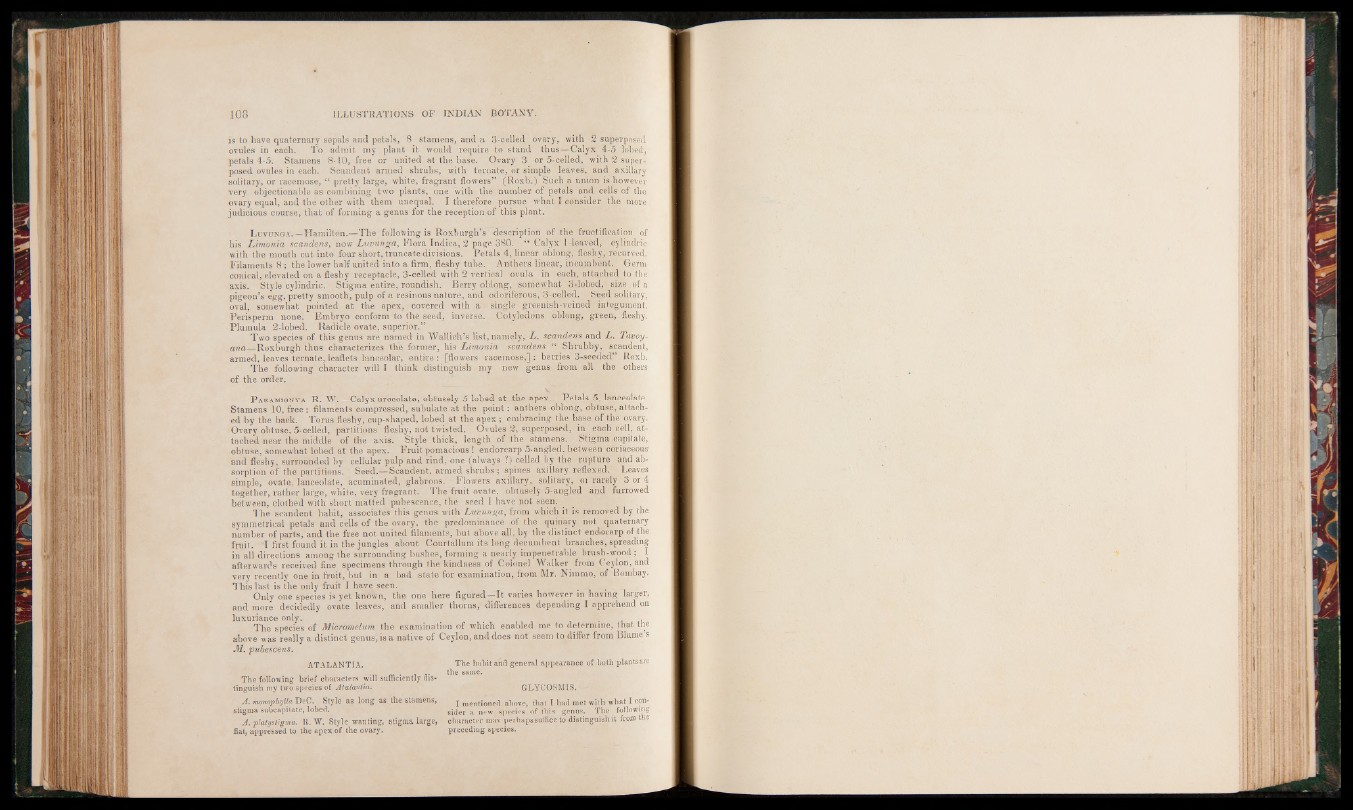
is to have quaternary sepals and petals, 8 stamens, and a 3-celled ovary, with 2 superposed
ovules in each. To admit my plant it would require to stand thus—Calyx 4-5 lobed,
petals 4-5. Stamens 8-10, free or united at the base. Ovary 3 or 5-celled, with 2 superposed
ovules in each. Scandent armed shrubs, with ternate, or simple leaves, and axillary
solitary, or racemose, “ pretty large, white, fragrant flowers” (Roxb.) Sueh.a union is however
very objectionable as combining two plants, one with the number of petals and cells of the
ovary equal, and the other with them unequal. I therefore pursue what I consider the more
judicious course, that of forming a genus for the reception of this plant.
L uvunga.—Hamilton.—The following is Roxburgh’s description of the fructification of
his Limonia scandens, now Luvunga, Flora Indica, 2 page 380. “ Calyx 1-leaved, cylindric
with the mouth cut into four short, truncate divisions. Petals 4, linear oblong, fleshy, recurved.
Filaments 8 ; the lower half united into a firm, fleshy tube. Anthers linear, incumbent. Germ
conical, elevated on a fleshy receptacle, 3-celled with 2 vertical ovula in each, attached to the
axis. Style cylindric. Stigma entire, roundish. Berry oblong, somewhat 3-lobed, size of a
pigeon’s egg, pretty smooth, pulp of a resinous nature, and odoriferous, 3-celled. Seed solitary,
oval, somewhat pointed at the apex, covered with a single greenish-veined integument.
Perisperm none. Embryo conform to the seed, inverse. Cotyledons oblong, green, fleshy.
Plumula 2-lobed. Radicle ovate, superior.”
Two species of this genus are named in Wallich’s list, namely, L. scandens and L. Tavoy-
ana—Roxburgh thus characterizes the former, his Limonia scandens “ Shrubby, scandent,
armed, leaves ternate, leaflets lahceolar, entire : [flowers racemose,} : berries 3-seeded” Roxb.
The following character will I think distinguish my new genus from all the others
of the order.
P aramignva R. W.—Calyx urceolate, obtusely 5-lobed at the apex. Petals 5, lanceolate.
Stamens 10, free : filaments compressed, subulate at the point: anthers oblong, obtuse, attached
by the back. Torus fleshy, cup-shaped, lobed at the apex ; embracing the base of the ovary.
Ovary obtuse, 5-celled, partitions fleshy, not twisted. Ovules 2, superposed, in each cell, attached
near the middle of the axis. Style thick, length of the stamens. Stigma capitate,
obtuse, somewhat lobed at the apex. Fruit pomacious ! endorcarp 5-angled, between coriaceous-
and fleshy, surrounded by cellular pulp and rind, one (always ?) celled by the rupture and absorption
of the partitions. Seed.—Scandent, armed shrubs; spines axillary reflexed. Leaves
simple, ovate, lanceolate, acuminated, glabrous. Flowers axillary, solitary, oi rarely 3: or 4
together, rather large, white, very fragrant. The'-"fruit ovate, obtusely 5-angled and furrowed
between, clothed with short matted pubescence, the seed I have not seen.
The scandent habit, associates this genus with Luvunga, from which it is removed by the
symmetrical petals and cells of the ovary, the predominance of thé quinary not quaternary
number of parts, and the free not united filaments, but above all, by the distinct endecarp of the
fruit. I first found it in the jungles about Courtallum its long decumbent branches, spreading
in all directions among the surrounding bushes, forming a nearly impenetrable brush-wood,’ I
afterwards received fine specimens through the kindness of Colonel Walker from Ceylon, and
very recently one in fruit, but in a bad state for examination, from Mr. Nimmo, of Bombay.
This last is the only fruit I have seen.
Only one species is yet known, the one here figured—It varies however in having larger,
and more decidedly ovate leaves, and smaller thorns, differences depending I apprehend on
luxuriance only. | ,
The species of Micromelum the examination of which enabled me to determine, that the
above was really a distinct genus, is a native of Ceylon, and does not seem to differ from Blume s
M. pubescens.
ATALANTIA.
The following brief characters will sufficiently distinguish
my two species of Atalantia.
A . monophylla DeC. Style as long as. the stamens,
stigma subcapitate, lobed.
A . platystigma. R. W. Style wanting, stigma large,
flat, appressed to the apex o f the ovary.
The habit and general appearance of both plants are
the same.
GLYCOSMIS. —
I mentioned above, that I had met with what I consider
a new species of this genus. The following
character may perhaps suffice to distinguishit from the
preceding species.